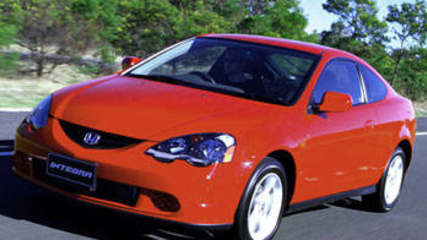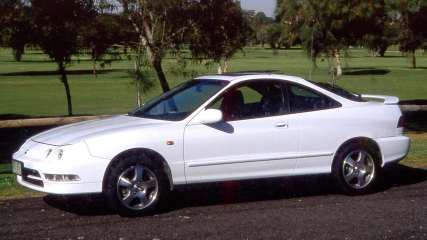Used Honda Integra review: 1993-2001
By Graham Smith · 28 Jan 2009
Before 1993 Honda’s Integra suffered from the same soft girlie image that afflicted most Japanese sports coupes, but the sleek new coupe that came that year shrugged off the ‘hairdresser’ tag to become a credible power player. The earlier Integra was a pretty car with sporting pretensions, but its performance failed to meet the expectations created by its styling and left buyers feeling let down. If sports car drivers sneered at its lack of get up and go the Integra did have plenty of admirers who loved its clean lines and stylish look and didn’t really care about its performance.That all changed in 1993 when the Integra underwent a transformation. It was one that would have a far reaching effect on the industry and result in a number of really competent and credible sports coupes being produced by a number of car companies.That transformation came in the form of Honda’s hot VTEC engine. It was really an all-purpose engine that overcame the limitations of small capacity with an innovative system, which varied valve timing and intake tract length. The result was bags of torque at low speeds for smooth drivability and miserly fuel consumption, and a powerful punch for plenty of get up and go at higher speeds.MODEL WATCHThe new Integra coupe was an all-new stylish, front-wheel drive three-door hatch. It had an all-new body, which was much stiffer than its predecessor providing a stable foundation for the sort of sharp responsive handling the Integra would become renowned for.It really was a car that changed the perception of Japanese sports coupes, and gave them new credibility. Not all of the Japanese carmakers followed Honda’s lead immediately, but most were eventually forced to follow and the result was a new generation of sports coupes that really were genuinely sporting.There were two models. The GSi was a combination of sporty styling and a flexible 1.8-litre four cylinder engine with the choice of a five-speed manual gearbox or four-speed auto transmission.It had multipoint electronic fuel-injection and put out a respectable 107 kW, which would have been quite respectable had it not been for the clever VTEC engine that powered the hot VTi-R model.The VTi-R was a revelation. Its VTEC 1.8-litre engine boasted twin camshafts with four valves per cylinder and electronic multipoint fuel-injection, and cleverly varied the valve timing and intake manifold length for optimum performance right through the rev range. The result was peak power of 125 kW at a heady 7300 revs and top torque of 173 Nm at 6200 revs.In practice that meant low-end punch for smooth drivability and efficient running which wasn’t compromised in the pursuit of top-end power. The VTi-R was remarkably smooth and tractable around town where it would roll along smoothly and unfussed, but when you opened the throttle and asked for it to perform it would, and how!It was now hairy-chested and great fun to drive. Before the Subaru WRX there wasn’t much better than the Integra VTi-R on our roads.There was no doubt that Honda intended the Integra, in VTi-R guise as least, to be a full-on performance car. The spirited performance of the engine was enough to convey that message to anyone who cared to use their right foot.The engine performance was matched by sharp and responsive handling of the VTi-R’s sports suspension, but it also came with a hard ride that made it difficult to live with day in day out.Inside the Integra was a little cramped, and its dark trim colours made it a little gloomy.The Integra was well equipped. The GSi featured an adjustable steering column, central locking, power windows and mirrors, power steering, a radio cassette sound system with four speakers, and a sunroof. A driver’s airbag was added in 1994, and ABS became standard in 1998. Extras included air-conditioning, CD player and rear spoiler.In addition to the GSi features, the VTi-R also had standard ABS brakes, driver’s airbag, ally wheels, and sports suspension.IN THE SHOPHondas generally enjoy well earned respect from mechanics who universally praise their quality and reliability, and the Integra is no exception.Prior to the arrival of the prestige Japanese brands, such as Lexus, Honda was regarded as the best Japanese carmaker, and mechanics are happy to report they remain solid and reliable even at high mileage. One mechanic even went so far as to say 300,000 km is well within their reach without any real loss of integrity.Parts prices are a problem, however, and Honda is renowned to have some of the most expensive spares in the business, so you need to be prepared for a big spend if something does go amiss.It’s also worth checking for a service record. The Honda engines aren’t free spinning and a cam timing belt failure, breakage or jumping, can lead to very expensive internal engine damage so it’s well worth checking that the belt has been changed at the recommended intervals.Metallic paint can be difficult to match so look for mismatches that might indicate crash damage, and carefully check plastic bumpers for chips and scratches that can be expensive to fix.Inside, expect to find heavy wear on the side bolsters of the sports seats, and wear on the carpet underfoot. Otherwise the interior stands up well with quality plastic parts that don’t unduly distort and are well retained.LOOK FOR:• verifiable service record that shows regular cam belt changes.• tight rigid body.• sharp, responsive handling.• zippy performance from VTEC engine.• high spares prices.










